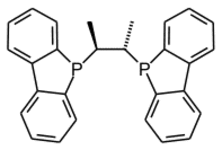Chirale Metallkomplexe
Chiral Metal Complexes
Numbers in square brackets refer to the List of Publications
Chiral Phosphines & Chiral Complexes
This is a field we have entered only recently. Out of our work on the use of transition metal complexes as chiral auxiliaries (see Sulfur Chemistry) a need for chiral chelate phosphines with special properties arose. As a first example, (2S,3S)-bis(dibenzophospholyl)butane, a rigid analog of the well-known (S,S)-CHIRAPHOS was synthesized and converted into a series of ruthenium complexes [89].
Following up on our earlier work on chiral (still racemic) rhenium thiolate and thioaldehyde complexes of the types [CpRe(NO)(PR3)(SCH2R')] and [CpRe(NO)(PR3)(S=CHR')]+ [70, 91, 93, 96] we began to investigate new methods to obtain such complexes in enantiomerically pure form. Quite promising in this regard were chiral, hemilabile (P,O)- and (P,S) ligands which could easily be converted into diastereomeric rhenium complexes. These complexes were found to undergo reversible chelate ring closure / ring opening reactions [118, 119].

Similar (P,N) ligands proved to be even more useful as they provided a direct access to enantiomerically pure half-sandwich rhenium complexes through a diastereoselective proton transfer step [122].
These complexes will now be investigated as templates in diastereoselective addition reactions of coordinated ligands.


![Molecular Structure of [CpRu{(S,S)-(C12H8P)CHMeCHMe (PC12H8)}Cl]](/fileadmin/_processed_/5/0/csm_Hagel-1_01_08f18be926.jpg)
![Molecular structure of (RRe,SP/SRe,RP)-[CpRe(NO){P(Me) (Ph)(2-C6H4OMe)}(CH3)]](/fileadmin/_processed_/e/d/csm_Dilsky-05_01_1c2aed4ad5.jpg)
![Structure of the cation (RRe,SP/SRe,RP)-[CpRe(NO) {P(Me)(Ph)(2-C6H4OMe)}(THF)]+](/fileadmin/_processed_/c/6/csm_Dilsky-08_fa50782b94.jpg)
![Structure of the cation (RRe,SP/SRe,RP)-[CpRe(NO) {P(Me)(Ph)(2-C6H4NMe2)}]+](/fileadmin/_processed_/8/4/csm_Bock-1_e8b0929e48.jpg)
![Molecular structure of (RRe,SP)-[CpRe(NO){P(Me)(Ph) (2-C6H4NMe2)}(CH3)]](/fileadmin/_processed_/c/7/csm_Bock-3_5199d59c3e.jpg)




